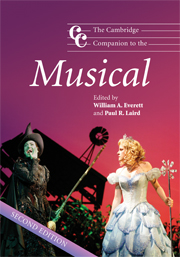Book contents
- Frontmatter
- Part I Adaptations and transformations: before 1940
- Part II Maturations and formulations: 1940–1970
- Part III Evolutions and integrations: after 1970
- 11 Stephen Sondheim and the musical of the outsider
- 12 Choreographers, directors and the fully integrated musical
- 13 From Hair to Rent: is ‘rock’ a four-letter word on Broadway?
- 14 The megamusical: the creation, internationalisation and impact of a genre
- 15 ‘Something borrowed, something blue’: the marriage of the musical and Europe
- 16 New horizons: the musical at the dawn of the twenty-first century
- Part IV Legacies and transformations
- Notes
- Select bibliography
- Index
12 - Choreographers, directors and the fully integrated musical
from Part III - Evolutions and integrations: after 1970
Published online by Cambridge University Press: 28 September 2011
- Frontmatter
- Part I Adaptations and transformations: before 1940
- Part II Maturations and formulations: 1940–1970
- Part III Evolutions and integrations: after 1970
- 11 Stephen Sondheim and the musical of the outsider
- 12 Choreographers, directors and the fully integrated musical
- 13 From Hair to Rent: is ‘rock’ a four-letter word on Broadway?
- 14 The megamusical: the creation, internationalisation and impact of a genre
- 15 ‘Something borrowed, something blue’: the marriage of the musical and Europe
- 16 New horizons: the musical at the dawn of the twenty-first century
- Part IV Legacies and transformations
- Notes
- Select bibliography
- Index
Summary
Can one recapture the excitement that A Chorus Line brought to Broadway? The Broadway musical seemed moribund in the middle of the 1970s. The big hits of the previous decade, such as Hello, Dolly!, Fiddler on the Roof and Man of La Mancha, had closed and the era of the great musical plays that followed the Rodgers and Hammerstein model was over. Stephen Sondheim and Hal Prince combined for major artistic successes between 1970 and 1973 with Company, A Little Night Music and Follies, but their appeal was limited, as can be seen by the length of their runs and their mixed commercial success. The rock musical had become a Broadway reality with Hair, Two Gentlemen of Verona and other shows, but rock was a new musical language that many in the traditional Broadway audience had not yet accepted. Creators of the musical theatre searched for a new mould that might combine new musical styles and contemporary thinking with tradition, building upon the genre's proud history. A Chorus Line did all of this as a veritable celebration of Broadway dance and dancers, bringing new life to the genre and taking it into the colossal hit era of six-thousand-performance runs.
Those who saw A Chorus Line during its original run will not easily forget it. The plot was minimal and somewhat artificial, but the characters were engrossing. We recognised types of people that we knew and with each part of their stories our fascination grew. The singing and dancing had a special immediacy because, within the world that the director Michael Bennett magically created, we knew that these characters would express themselves through music and movement.
- Type
- Chapter
- Information
- The Cambridge Companion to the Musical , pp. 220 - 234Publisher: Cambridge University PressPrint publication year: 2008
- 1
- Cited by



